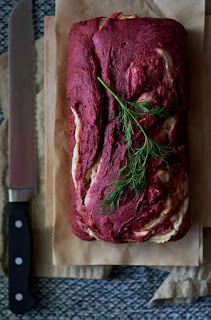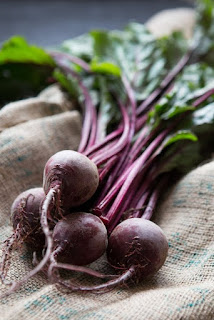This gorgeous,
luscious beetroot loaf is so hard to resist, especially when coupled with sweet
caramelized red onion marmalade and melt in your mouth cream cheese or Camembert.
Here’s the
recipe, sourced from http://www.10thkitchen.com/
I couldn’t
resist.
For bread
- 1 1/4 cups self-raising flour
- 1 cup whole wheat flour
- 1 tablespoon baking powder
- 1 teaspoon salt
- 1 cup roasted beet puree (recipe below if you need it)
- 3 eggs
- 2/3 cup milk
- 1/2 brick unsalted butter, melted and cooled
For cream cheese swirl
- 115 grams cream cheese
- 1 egg
- 3 tablespoons self-raising flour
- 1 ½ tablespoons fresh chopped dill
- Pinch of salt
Method
·
To make roasted beet puree, wrap three medium washed, trimmed, and dried
beets in foil and roast in a 400-degree oven for about 40 minutes, until
they're pierced easily with a sharp knife.
·
Cool, peel, and puree in a blender or food processor until smooth.
·
Preheat oven to 350 degrees. Generously grease out a 9x5 loaf pan with
butter.
·
In a large bowl, whisk together the self-raising flour, whole wheat
flour, baking powder and salt.
·
In a medium bowl, whisk together the beet puree with eggs, milk, and
melted butter. Stir the mixture into the flour mixture with a wooden spoon until
slightly blended through.
·
To make the cream cheese swirl, combine cheese, egg, four, dill and salt
in a small bowl and stir until smooth.
·
Spoon about 2/3s of the beet batter into the buttered pan and spread to
the edges to even out. Dollop cream cheese mixture over it, then top with the
rest of the beet mixture. Run a butter knife in a swirling motion through the
layers to create the swirl pattern.
·
Smooth out the top a little, then bake for 45-50 minutes, until a
toothpick inserted in the middle comes out clean (a few moist crumbs are fine).
·
Cool on a wire rack for about 10 minutes before removing from pan.
·
Serve warm or at room temperature, along with soft camembert or brie,
hummus, red onion marmalade, fig or grape jam.
·
Be prepared to be sent into orbit in culinary delight.




















